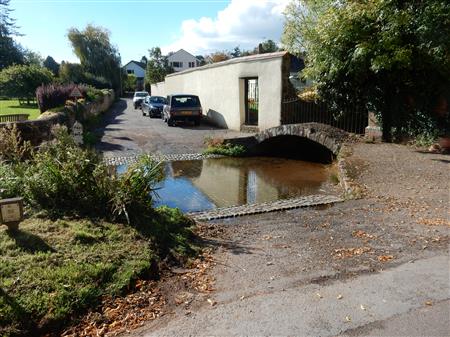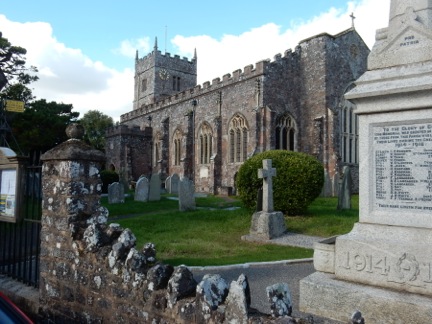Thorverton is located in mid Devon, about a mile west of the River Exe, some eight miles (13k) from Exeter city centre. It is almost centrally located between Exeter and the market towns of Tiverton, Cullompton and Crediton and includes the hamlets of Yellowford and Raddon.
Thorverton has a current population of about 900. The village has two churches, two public houses, a primary school, a doctor's surgery, a post office and a village shop. There are many local organisations to join, such as the History Society, Art Group, Women's Institute, Ladies Group, Amateur Dramatic Society, Bridge Circle, Walking, Football, Golf and Cricket Clubs. The Millennium Green provides a large open space for recreation and for walking alongside the pretty stream which runs through the centre of the village.There is also a Recreation Ground with a football pitch, play equipment, adult gym equipment and a wildlife garden for all to enjoy. Allotments are on offer for keen gardeners too.
The Memorial Hall is the hub of the village and provides a centre for entertainment, clubs, weddings, parties and even plays and pantomimes. There is a monthly Saturday Market at the Hall where a hearty big breakfast can be purchased and local produce, including meat, vegetables, cakes and bric-a-brac can be bought. The Woman's Institute also has monthly coffee mornings and markets in their hut which adjoins the Recreation Ground. A monthly local village magazine, Focus on Thorverton, is produced by volunteers and contains all you need to know about village events and is available at the post office or shop. There are also Thorverton groups on Facebook and Nextdoor, which facilitate communications about local events.
The Church, St Thomas of Canterbury, is one of 10 that comprise the Netherexe Parish Mission Community, whose Team Rector lives in Thorverton. Some services are held jointly with members of the Baptist Church, whose Minister is also a resident of the village. There are two medical practices available, one in Thorverton linked with Crediton and one across the river in Silverton. Most children go to the pre-school, then to the Church of England primary school, which is one of five schools in the Exe Valley Federation that share some of their facilities and experiences under a single Executive Head Teacher and a governing body drawn from the parishes concerned. For their secondary education they go to the Queen Elizabeth Community College in Crediton, where they may remain for 'A' Levels or from which they may transfer to Exeter College. Children in the northern part of the parish fall in a different catchment area and go first to Bickleigh and then to Tiverton schools.
Local buses visit the village regularly and the nearest train stations are Exeter St David's and Tiverton Parkway. The National Trust's Killerton House and Gardens is nearby and is well worth a visit along with Fursdon House, the Devon Railway Centre and Bickleigh Mill.
Some brief historical notes about Thorverton
Thorverton came into being as a settlement on high ground close to a fordable part of the prehistoric route between the south-east of England and the far south-west. Nearly twenty thousand flint tools have been found in the immediate vicinity as evidence of early inhabitants. Evacuations in 2019 in a field between the parish church and Lynch Farm uncovered further evidence of Neolithic settlement activity from around five thousand years ago. The Romans came here, too: the remains of one villa or signal-station overlooking the river have been partly excavated, and Roman coins have been discovered elsewhere in the parish.
 Very little is known of what happened here in mediaeval or Tudor times, but during the Civil Wars in the seventeenth century the stone bridge over the Exe was an important crossing place for troops of both sides and for a while Thorverton was the headquarters of Royalist army which the Prince of Wales - later Charles II - came out from Exeter to review. The parish was once of considerable significance as the centre of the lucrative serge-making industry, and later it remained prosperous and self-sufficient through successful sheep- and cattle-farming by local yeomen.
Very little is known of what happened here in mediaeval or Tudor times, but during the Civil Wars in the seventeenth century the stone bridge over the Exe was an important crossing place for troops of both sides and for a while Thorverton was the headquarters of Royalist army which the Prince of Wales - later Charles II - came out from Exeter to review. The parish was once of considerable significance as the centre of the lucrative serge-making industry, and later it remained prosperous and self-sufficient through successful sheep- and cattle-farming by local yeomen.
In the mid-nineteenth century the population had risen to nearly 1500, but agricultural depression and later mechanization, the development of new industries elsewhere, and opportunities to emigrate led to a steady decline. By 1911 the population was less than half that of 1851 and by 1961 was only 674. Since then the numbers have risen again, with many inhabitants working in the city of Exeter. There are still around a dozen working farms in what remains essentially a rural parish.
